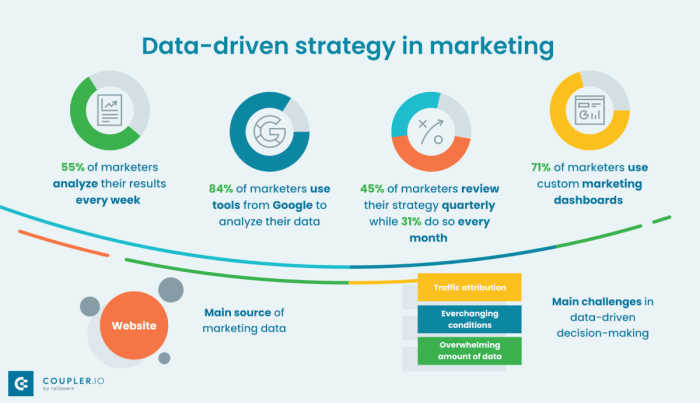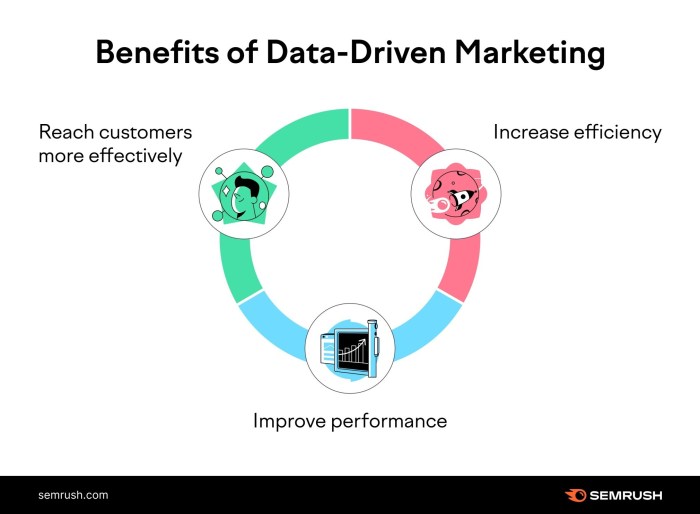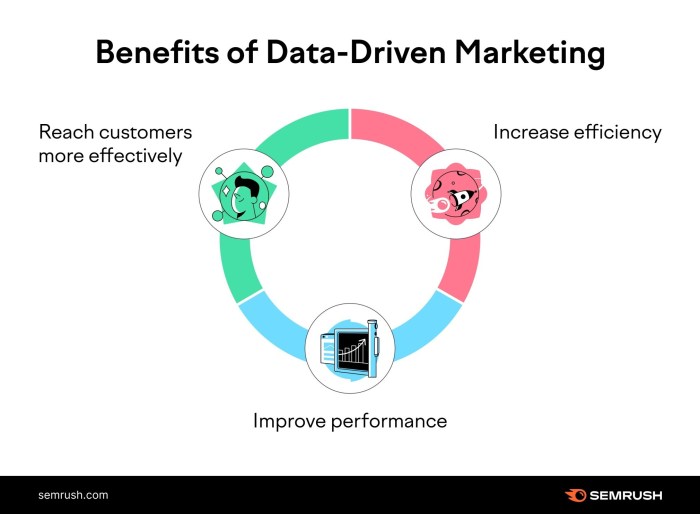Creating a Data-Driven Marketing Plan sets the stage for a dynamic journey into the realm of marketing strategies fueled by data insights. Dive in as we explore the key components and best practices that drive successful data-centric campaigns.
Introduction to Data-Driven Marketing Plan

A data-driven marketing plan is a strategic approach that utilizes data and analytics to guide marketing decisions and campaigns. By analyzing consumer behavior, preferences, and interactions, businesses can tailor their marketing efforts to target specific audiences effectively.
Using data in marketing strategies is crucial in today’s digital age as it allows companies to understand their customers better, personalize messaging, and optimize marketing ROI. Data-driven marketing enables businesses to make informed decisions based on real-time insights rather than relying on guesswork or assumptions.
Examples of Successful Data-Driven Marketing Campaigns
- Amazon’s personalized recommendation system, which suggests products based on previous purchases and browsing behavior, leading to increased sales and customer satisfaction.
- Netflix’s content recommendation algorithm, which analyzes viewing habits to suggest shows and movies tailored to individual preferences, enhancing user engagement and retention.
- Starbucks’ mobile app, which uses customer data to offer personalized promotions, rewards, and recommendations, driving customer loyalty and repeat purchases.
Setting Objectives and Goals
In order to create a successful data-driven marketing plan, it is crucial to set clear objectives and goals that align with the overall business objectives. This ensures that all marketing efforts are focused and working towards achieving the company’s long-term vision.
Aligning Marketing Goals with Business Objectives
When setting marketing goals, it is important to consider how they contribute to the broader business objectives. For example, if the company’s goal is to increase revenue by 20% within the next year, the marketing goal could be to generate a certain number of leads or increase conversion rates to support this revenue target.
- Ensure that marketing goals are in line with the overall business strategy to maximize impact.
- Regularly communicate with key stakeholders to understand any shifts in business priorities and adjust marketing goals accordingly.
- Track progress towards business objectives through key performance indicators (KPIs) that align with marketing goals.
Setting SMART Goals for a Data-Driven Marketing Plan
Setting SMART goals is essential for creating a focused and measurable marketing plan that drives results. These goals are Specific, Measurable, Achievable, Relevant, and Time-bound, providing a clear framework for success.
- Specific: Clearly define what you want to achieve with your marketing efforts, such as increasing website traffic or improving lead quality.
- Measurable: Establish metrics and KPIs to track progress towards your goals, allowing you to measure success and make data-driven decisions.
- Achievable: Set goals that are realistic and attainable based on available resources and market conditions.
- Relevant: Ensure that your goals align with the overall business objectives and contribute to the company’s growth and success.
- Time-bound: Set deadlines for achieving your goals to create a sense of urgency and accountability within your marketing team.
Significance of Clear Objectives in Measuring Marketing Success
Clear objectives are essential for measuring the effectiveness of your marketing efforts and determining ROI. By setting specific goals and tracking progress against them, you can identify what strategies are working and make data-driven adjustments to optimize performance.
Clear objectives provide a benchmark for success and help you evaluate the impact of your marketing campaigns accurately.
Measuring success against predefined goals allows you to demonstrate the value of marketing initiatives to key stakeholders.
Clear objectives enable you to focus on metrics that matter most to the business, driving continuous improvement and innovation in your marketing strategies.
Collecting and Analyzing Data
Data collection and analysis are crucial components of a data-driven marketing plan. By utilizing various sources and tools, marketers can gather valuable insights to make informed decisions and optimize their strategies.
Different Sources for Collecting Marketing Data
- Social media platforms: Monitoring engagement, demographics, and trends on platforms like Facebook, Twitter, and Instagram.
- Website analytics: Utilizing tools like Google Analytics to track website traffic, user behavior, and conversions.
- Email marketing data: Analyzing open rates, click-through rates, and subscriber behavior to improve email campaigns.
- Customer surveys and feedback: Gathering direct feedback from customers through surveys, reviews, and interviews.
Tools and Techniques for Data Analysis in Marketing
- Data visualization tools: Using platforms like Tableau or Power BI to create visual representations of data for easier interpretation.
- Statistical analysis software: Employing tools like SPSS or R for advanced statistical analysis to identify patterns and correlations in data.
- Machine learning algorithms: Implementing algorithms to predict customer behavior, segment audiences, and personalize marketing efforts.
- A/B testing: Conducting experiments to compare the performance of different marketing strategies and optimize campaigns based on data-driven insights.
Best Practices for Ensuring Data Accuracy and Reliability
- Regular data cleaning: Removing duplicates, correcting errors, and updating outdated information to maintain accurate datasets.
- Consistent tracking and reporting: Establishing standardized processes for data collection and reporting to ensure consistency and reliability.
- Data security measures: Implementing protocols to protect sensitive customer data and comply with privacy regulations like GDPR.
- Cross-referencing data sources: Verifying data accuracy by comparing information from multiple sources to identify discrepancies or inconsistencies.
Target Audience Segmentation
In the world of data-driven marketing, segmenting target audiences is crucial for creating effective and personalized marketing strategies. By dividing your audience into smaller, more specific groups based on shared characteristics or behaviors, you can tailor your messages and offerings to meet their unique needs and preferences.
Methods for Creating Customer Personas
Customer personas are fictional representations of your ideal customers, based on real data insights. Here are some methods for creating customer personas based on data:
- Conduct surveys and interviews to gather information about your customers’ demographics, interests, and pain points.
- Analyze website and social media analytics to understand how different segments of your audience engage with your content.
- Use CRM data to track customer interactions and identify patterns in their behavior.
Importance of Segmentation in Personalized Marketing
Segmentation allows you to deliver more targeted and relevant messages to your audience, leading to higher engagement and conversions. By understanding the unique needs and preferences of each segment, you can create personalized marketing campaigns that resonate with your customers on a deeper level. This, in turn, enhances customer satisfaction and loyalty, ultimately driving business growth.
Implementing Data-Driven Strategies: Creating A Data-Driven Marketing Plan

Implementing data-driven strategies in marketing campaigns is crucial for achieving success in today’s competitive landscape. By leveraging data effectively, businesses can make informed decisions, personalize their marketing efforts, and ultimately drive better results. Let’s dive into the steps for implementing data-driven strategies, examples of how data influences decision-making in marketing, and the role of A/B testing in data-driven optimizations.
Steps for Implementing Data-Driven Strategies, Creating a Data-Driven Marketing Plan
- 1. Define Key Metrics: Identify the key performance indicators (KPIs) that align with your marketing objectives.
- 2. Data Collection: Gather relevant data from various sources such as website analytics, social media insights, and customer feedback.
- 3. Data Analysis: Analyze the data to gain valuable insights into customer behavior, preferences, and trends.
- 4. Strategy Development: Develop targeted marketing strategies based on the insights derived from data analysis.
- 5. Implementation and Monitoring: Execute the strategies and continuously monitor performance to make data-driven optimizations.
Examples of Data Influencing Decision-Making in Marketing
- – Utilizing customer purchase history to personalize product recommendations.
- – Analyzing website traffic patterns to optimize content placement and improve user experience.
- – Segmenting email campaigns based on demographic data to increase engagement and conversion rates.
The Role of A/B Testing and Data-Driven Optimizations
- A/B testing involves comparing two versions of a marketing asset to determine which performs better based on data-driven insights.
- Data-driven optimizations utilize A/B testing results and other data to refine marketing strategies for improved performance.
- By continuously testing and optimizing based on data, businesses can enhance their marketing efforts and achieve higher ROI.
Measuring Performance and ROI
In order to determine the success of a data-driven marketing plan, it is crucial to measure performance and return on investment (ROI) effectively. By analyzing key metrics, tracking ROI, and leveraging data insights, marketers can continuously improve their marketing efforts.
Key Metrics for Measuring Success
- Conversion Rate: This metric measures the percentage of website visitors who take a desired action, such as making a purchase or signing up for a newsletter.
- Customer Acquisition Cost (CAC): CAC helps in understanding how much it costs to acquire a new customer through marketing efforts.
- Customer Lifetime Value (CLV): CLV estimates the total revenue a business can expect from a customer throughout their entire relationship.
- Return on Ad Spend (ROAS): ROAS calculates the revenue generated for every dollar spent on advertising.
Tools and Methods for Tracking ROI and Performance Analytics
- Google Analytics: A powerful tool for tracking website traffic, user behavior, and conversion rates.
- Marketing Automation Platforms: Platforms like HubSpot and Marketo provide comprehensive analytics to track campaign performance.
- A/B Testing: Testing different variations of marketing campaigns to determine which yields better results.
- CRM Systems: Customer Relationship Management systems help in tracking customer interactions and measuring ROI.
Driving Continuous Improvement with Data Insights
Data insights derived from performance metrics can guide marketers in making informed decisions, optimizing campaigns, and personalizing messaging for better results.
By analyzing data trends, identifying areas of improvement, and implementing data-driven strategies, marketers can adapt to changing consumer behaviors and enhance the overall effectiveness of their marketing efforts.

